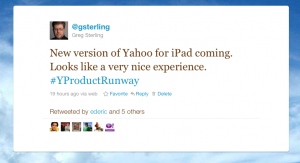Where’s Yahoo’s “Big Vision”? Maybe It Doesn’t Need One
There are a number of critical articles, even complaints, coming out of yesterday’s Yahoo press event featuring new Chief Product Officer Blake Irving. The main portion of the event had Irving and CTO Raymie Strata discussing Yahoo strategy and reiterating that Yahoo wasn’t simply a media company but a company with deep technology as well. […]
There are a number of critical articles, even complaints, coming out of yesterday’s Yahoo press event featuring new Chief Product Officer Blake Irving. The main portion of the event had Irving and CTO Raymie Strata discussing Yahoo strategy and reiterating that Yahoo wasn’t simply a media company but a company with deep technology as well.
Some of the informal comments and conversations that immediately followed the 90-minute discussion were along the lines of “We’ve heard this before, what’s new?” or “Where’s the vision?”
 During the Q&A portion of the session Irving stumbled a bit when asked by the BBC’s Maggie Shields to sum up what Yahoo was in a sentence. He rattled off a list of things.
During the Q&A portion of the session Irving stumbled a bit when asked by the BBC’s Maggie Shields to sum up what Yahoo was in a sentence. He rattled off a list of things.
Indeed, Irving had said during his opening, “People have seen Yahoo as disassociated set of verticals. Going forward there’s going to be ‘one Yahoo.’ You’re going to see us transition to an on network and off network player — something that you take with you and not as much as a place where you go.”
This sort of thing has been said before (remember YOS?).
During his opening remarks Irving laid out some elements (literally as a periodic table) of Yahoo’s “new” strategy:
- Building an ecosystem outside the Yahoo network: both ads and content. Irving suggests that Yahoo might create a “content exchange” like the RightMedia ads exchange. There will also be a focus on third party sites
- Personal relevance through data. Irving says 50% of Yahoo’s 600 million log in. “We are going to be striving for 100% authentication over the next three years.” (By honoring OpenID and not just Yahoo IDs.)
- Be where the consumer is (mobile and tablets will be equally important)
- Social: own real social relationships on the web. He implies that Yahoo’s social strategy involves smaller groups than large public networks
- Best in class services: Irving asserts that this is Yahoo’s challenge/task across devices
Beyond these principles, Irving previewed a few specifics: a rebuilt Yahoo Mail with speed and design improvements, some search UI changes that would be more visually pleasing and enable users to “act” on search results more than today. Irving said, “We’re going to bring you as close to that ‘answer’ as possible” (including conducting transactions from the search results page).
There was also a brief visual tease of a forthcoming iPad app for Yahoo that looked pretty nicely designed.
After Irving, CTO Raymie Stata got up and talked about bringing a “search mindset” to the whole of Yahoo and infusing everything being done with “big science” to generate “awesome experiences.” He went on to discuss Yahoo’s architecture and infrastructure, saying that many changes had been made to lay the groundwork for a “faster, more iterative” approach to product development going forward (to use Irving’s words).
Though both men were passionate and articulate the discussion felt a bit like a meal without the entree. But then I went into the hall, which not everyone did, and saw some of the product demos and talked to some of the product people about specifics. After those conversations my perception of things changed considerably.
Reporters who wrote their stories “in the room” without the benefit of seeing the demos only heard what sounded like a familiar aspirational speech. But if you actually saw some of the product specifics it put some interesting “meat on the bones” of Irving and Stata’s general remarks.
Asked to discuss my reactions immediately following the press conference, I told the BBC that Yahoo has “strong products and strong content but they don’t have . . . . products that have gotten people excited.” I told the Wall Street Journal that “They need to show up with sexy, exciting stuff to regain some of their old credibility.” These were my immediate, quick reactions to the general and short-on-specifics speeches. But I felt differently after speaking to the product people.
Out in the hall I saw:
- A new version of Yahoo Messenger than includes a “Face Time” like PC-to-smartphone video chat capability
- A better looking and seemingly faster Yahoo Mail
- A very well-designed version of Yahoo for the iPad (nothing like the browser version) that was visually rich and capable of customization
- Some impressive new rich media ad units
- A much improved version of Yahoo Groups that was visually more pleasing and seemingly more useful
- A partly new search interface with some intriguing possibilities, including the presentation of rich display ads in the “accordion” module at the top of results:
Yahoo Search SVP Shashi Seth told me that this accordion module, which allows users to quickly browse through information, was testing very well and would be coming this fall. Whether you like it or not personally it’s the kind of thing that Yahoo has said it was going to do in the post-Bing era: innovate on top of the Microsoft index.
I came away from these and a couple of other discussions thinking (in contrast to my immediate remarks) maybe Yahoo doesn’t need a single big vision. Maybe that’s not possible given Yahoo’s legacy. Instead, maybe it just needs to do what it does already but do it better and update it more frequently. In other words make its products better and easier to use and bring out improvements more rapidly. (There are some who might argue it has lost some of the engineering talent required to do so.)
Yet this is precisely what Blake Irving said that Yahoo would do now: “iterate more rapidly.” In a sense Yahoo doesn’t need lots of flashy new stuff so much as it needs to stop neglecting some of the assets it already owns. That was acknowledged to me several times in my demo-related conversations. Yahoo Groups is a case-in-point.
Yahoo says it has 10 million groups, with a total of 115 million users globally. By comparison, MySpace officially claims just over 120 million users globally (though “active” users may be fewer). Groups was a social network of sorts before there were social networks.
Yahoo has in the past tried to turn Mail into a social network but Yahoo Groups is already a version of what Google has been considering around smaller sets of connections; it has just been long neglected. A better designed and more functional Yahoo Groups, which is what I saw, could represent a major avenue into “social networking” and it’s already there.
I’m not entirely reversing myself here. I do think that new and exciting products would help Yahoo. But I also believe that if Yahoo can do a better job of developing what it already has it can not only retain but grow usage and regain some of its lost “mojo” — whatever that is exactly.
Contributing authors are invited to create content for Search Engine Land and are chosen for their expertise and contribution to the search community. Our contributors work under the oversight of the editorial staff and contributions are checked for quality and relevance to our readers. The opinions they express are their own.
Related stories
New on Search Engine Land


